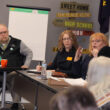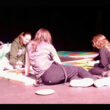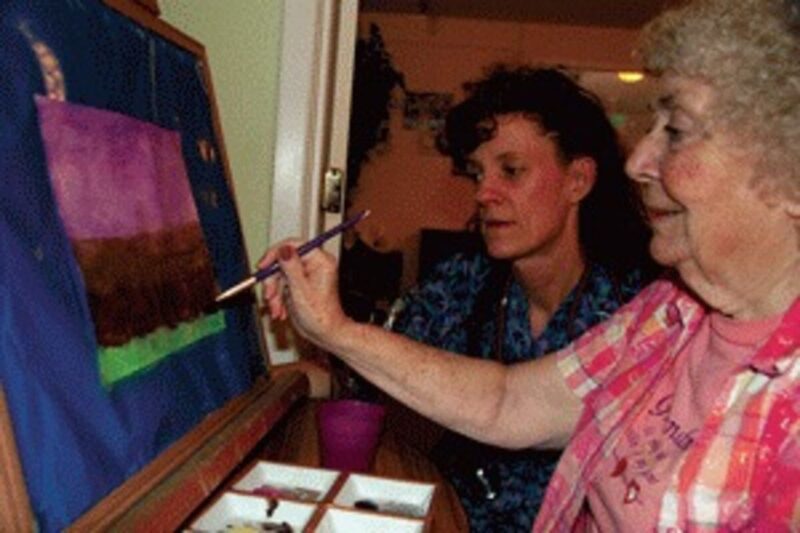Scott Swanson
Of The New Era
Twyla Fuson, a resident at Twin Oaks Rehabilitation Center in Sweet Home, enjoys painting.
She’d given up her art prior to moving to Twin Oaks, staffers there said. But when they discovered that she’d been a painter, they decided to get her to try it again.
Last Thursday night, after dinner, Fuson happily painted a landscape as staffers stopped by occasionally to check on her. They say her condition has improved noticeably since she got back into art.
Her return to her hobby is a result of a new program that’s been installed at Twin Oaks and at other homes operated by Avamere, Twin Oaks’ parent company.
It’s called “Best Friends,” after a book by that title written by Virginia Bell and David Troxel, which laid out a model of care for patients with dementia that is based on the presupposition that what a person with dementia needs most is someone who really cares about them.
“When people get to the point in their lives that they need to come live in a nursing home or assisted living, we really are charged with making their hopes and dreams come true, whatever they are,” said Linda Nickolisen, director of talent recruitment for Avamere. Nickolisen said she does “a lot of program development and training around person-centered care” for the company.
Best Friends, she said, is a person-directed model to provide care and services for a resident, “how they want it, when they want it, on their terms, rather than they come into a nursing home and have to live by other people’s standards.”
To do that requires learning about the person – their life history, their interests, their family.
“It’s a relationship,” Nickolisen said. “When you get to know somebody, you become their advocate. If we can find out what’s important to somebody, everything else kind of falls into place. That’s what a friend does for you. They help support you.
All of the staff at Twin Oaks have been trained in the model in an all-day workshop, a process that was completed at the end of January, Administrator John Buckley said.
“Each employee selected a best friend from among the residents,” he said. “We call it ‘community.’ It’s part of a culture of change.”
Over time, employees visit with their best friends and create a life storybook for the resident, which is available to other staff members, he said.
Nickolisen, who has worked with the elderly for more than 20 years, said most residents’ wants are “modest.”
“What people want is your time,” she said. “People need to be needed. These people have such amazing stories to tell. Their lives are so fascinating.”
Reviewing those lives can sometimes be helpful,
A resident in one Avamere home hated to brush his teeth. Nickolisen said she called a “learning circle” of staffers and learned that the man was used to brushing his teeth in the shower. Problem solved: the resident now brushes his teeth when he takes his morning shower.
“Now he brushes his teeth because they know what his memory of that is,” she said.
Buckley said that one of the Twin Oaks residents, who suffers from advanced dementia, used to be a tap dancer when she was in her 60s.
“We put on a video the family made so she could go back to that place,” he said.
Nickolisen said that in Wilsonville, where she is based, all employees, including the bookkeeper and the maintenance man, go through the training.
“We develop what we call ‘bullet cards,’ she said. “They’re just nice things to know about somebody so you can help them have a good day.”
Her bullet card, Nickolisen said, would note that she likes black coffee, likes to read the newspaper and is a National Public Radio fan.
Tanya Carter, a certified nurse’s aide at Twin Oaks, called Best Friends “awesome.”
“You learn more about their history, what they’ve gone through in their lifetime,” she said. “The more you know about somebody, the better you can handle them.”
In addition to the activity programs that are standard practice at nursing homes, caregivers in Best Friends are taught to look for opportunities to do things like sing to a resident as they’re being wheeled down the hall, whistle a tune, tell a joke – little things you can do throughout the day that you’d normally have as a younger person,” she said.
“It seems like you don’t need to teach someone to do that, but in the caregiving world where it’s so task-oriented, it’s important to train them to do that.”
‘During training, staff members are taught about how the brain operates and what happens to it as a person gets older or has a stroke or dementia.
“We have social behavior when all the brain cells are firing, but when you have cellular loss, you lose the ability to have that kind of control,” Nickolisen said. “Caregivers are taught not to take that personally. They’re taught that sometimes behavior is communication of an unmet need. Those people who can’t tell you what’s wrong will tell you by behavior.”
Buckley and Nickolisen said that staffers are taught to have “knack,” which is a problem-solving ability, doing things with a clever trick or strategy to make their jobs easier and have better outcomes for patients.
Buckley said that at Twin Oaks staff members put up photos of residents that were taken when they were young.
Nickolisen said that spending the time to get to know a resident actually makes the caregiver’s job easier and saves time.
“My belief is that staff retention is better because the work is not so hard,” she said. “Caregivers want to do the right things by residents. “Best Friends” gives the person the opportunity to do the right thing for the resident.
“For us the art of friendship is not buying gifts, or giving money. It’s about the gift of time, who I am – giving time and attention.”
Family members are enthusiastic about the program because of the individualized care they see their relatives receiving.
Jana Bishop, a licensed practical nurse at Twin Oaks, said she thinks the quality of care is better when she can get to know a patient.
“If you can make (a resident’s) quality of life better for five minutes, you’ve done your job,” she said. “That’s pretty much my statement of purpose as a nurse. That’s why I’ve stayed in geriatrics.”





